Features Glossary
3D Printing
3D printing is a process for making a physical object from a three-dimensional digital model, typically by laying down many successive thin layers of a material. Many types of 3D printers now exist that are able to create objects made of plastic, resin, paper, and various other materials. The reach of 3D printing in education seems boundless, as a plethora of applications exist for Science, Art, Math, History, Engineering, Architecture, and beyond.
ABOUT
3D Printing at The Digital Union
The Digital Union is the only department at Ohio State offering 3D printing to all students, staff, and faculty regardless of departmental affiliation, and for free! You can now submit 3D models to be printed in PLA filament on one of our two Prusa i3 MK3S+ printers or our Creality Ender-3 V2 at the Digital Union Prototyping Studio (Enarson Classroom Building Room 012).
Selection Process at the Digital Union
Submissions are selected are selected to be printed on a rolling basis. Priority is given to submissions that most strongly demonstrate the following qualities:
- originality (25%)
- academic need (25%)
- innovative, interesting, or meaningful (50%)
Submitters will receive an email confirming whether their entry has been selected, and then when it it ready to be picked up.
SOFTWARE
We recommend Tinkercad as a simple beginner-friendly program to create your own 3D model, however, several other software options are available on Digital Union computers. See this flowchart to help you decide. If you cannot create your own model, online communities such as Thingaverse and the Lulzbot Community, provide models or information for anyone to learn and download.
Cura LulzBot Edition
Available on Digital Union computers
About | Download
Tinkercad
Available anywhere, web based, no installation required, must sign up for an account
About | Learn | Sign Up
Blender
Available on Digital Union computers
About | Support | Download
Rhino
About | Support | Mac Download | Windows Download
Maya
Mudbox
HARDWARE
Creality Ender-3 V2
Prusa Original i3 MK3S+
TERMS
The Digital Union's 3D printing service is available to Ohio State students, faculty and staff to make three-dimensional objects in PLA plastic based on a user-submitted digital computer file (STL format).
I. Use
The 3D printer may be used only for lawful purposes. No one will be permitted to use the 3D printer to create material that is:
Prohibited by local, state or federal law.
Unsafe, harmful, dangerous or poses an immediate threat to the well being of others. (Such use may violate the terms of use of the manufacturer.)
Obscene or otherwise inappropriate for the University environment.
In violation of another's intellectual property rights. For example, the printer will not be used to reproduce material subject to copyright, patent or trademark protection.
II. Assessment
The Digital Union reserves the right to:
Refuse any 3D print request.
Use staff discretion to organize the print queue for overall efficient output.
Photograph all 3D objects printed; publicly share user-submitted information related to print jobs. Images and information will be used for monitoring, marketing.
Gather feedback from users.
Implement additional requirements to streamline the process of vetting, printing, and reporting.
III. Cost
3D printing through the Digital Union is free.
IV. Pickup
Items printed from the Digital Union 3D printer that are not picked up within 7 days after being printed become the property of the Digital Union. Items must be picked up by the individual who printed them, using his or her Buck-ID.
V. Access
Only Digital Union and ODEE staff may have hands-on access to the 3D printer.
HOW TO PRINT
3D printing at the Digital Union is free. Read Terms above, then Use this online form to submit an STL file of the 3D model to you wish to print. Each week, approximately ten submissions are selected to be printed the following week. Therefore, lead time is typically 2 weeks. Priority is given to submissions that demonstrate academic need, originality, and innovative potential.
RESOURCES
Sign up for free access to LinkedIn Learning! Choose your method of access, then learn everything you need to know at your own pace. Here are a few staff picks to get you started.
Up & Running w/ 3D Printing
Getting Started w/ MakerBot 3d Printers
Using 3D Printing Software
Rhino 5 Essential Training
Maya 2015 Essential Training
Mudbox 2013 Essential Training
Blender Essential Training
Structure of a 3D Print
Rapid Prototyping for Product Design
5 Resources for Finding 3D Models
What can you make w/ 3D Printing?
Deciding on Hollow or Solid 3D Prints
What is 3D Printing
How 3D Printing Works
FAQ
What if my submission isn't selected?
If you feel your submission strongly demonstrates the qualities prioritized, consider that it may have been rejected simply for the fact that we had reached our capacity for print jobs that week. You may try to submit again in the future.
How long will I have to wait for my model to be printed?
Up to two weeks. Please account for the time it will take for your submission to be reviewed by staff and placed through the print queue. Once your job reaches the printer, it may take anywhere from an hour to a couple of days to print, depending on the size, percentage infill, and complexity of the design. Once complete, staff will remove your model from the build plate. You will receive an email once your print is ready for pickup.
What colors of filament can I print at the Digital Union?
Black, white, red, and gray. During the submission process, you may indicate your color preference, which will be granted if available. If your color preference is not available, your object will be printed in one of the other colors listed unless you specify otherwise.
How large of an object can I print?
The maximum build volume is 254 mm x 254 mm x 210 mm (10 in x 10 in x 8.7 in).
Can I print without having to submit an STL file?
No. All users must go through the same submission process, which involves agreeing to the Terms, and providing an STL file of the object to be printed.
How is 3D printing relevant for education?
See examples of educational uses on 3D Printing Systems' website.
Adobe Creative Suite Software
Adobe Creative Suite software is designed to facilitate the creative process (such as video/audio/image creation and editing, computer programming, and collaboration software). Each of our Digital Union lab computers has the Adobe Suite installed.
Software in the suite includes but is not limited to:
- Photoshop
- InDesign
- Premiere
- Illustrator
Annotation Board
An annotation white board that enables touch navigation and notation using a pen, or stylus over lecture materials being displayed on the whiteboard.
Annotation Monitor
A podium monitor with interactive pen display designed to write over and highlight lecture materials being displayed to the class.
Audio Studio
About
An audio recording studio is a sound-insulated, quiet room equipped with tools that facilitate the recording and editing of audio files. Each space features unique tools, but builds on the basic setup of a microphone(s), software for audio capture and editing, and playback capabilities.
Location
The Digital Union's professional quality audio studio is located in Denney Hall. The studio is ideal for guests with advanced needs such as multi-track recording, microphones for a variety of instrument types, and advanced editing software.
Beginners are welcome, and staff are available to assist with the recording process.
Reservations
Call any Digital Union to reserve the recording studio in Denney. Click here to see phone numbers and directions. Please review our reservation guidelines prior to making an appointment.
Professional Audio Studio - Denney
Software
Most visitors use Garageband or Audacity; however, higher level audio software is also installed.
Hardware
Our audio hardware is connected to an iMac. A variety of microphones are available for users to choose from depending on the type of instrument being used.
Catchbox
The Catchbox is a wireless throwable microphone. Facilitate auddience engagement and interactive participation activities with a this wireless microphone. Please contact our Service Desk located in Enarson Classroom 009 during normal business hours to loan one out for your class. Please note that the Catchbox microphone will only work in wireless microphone enabled classrooms.
A few large lecture rooms have Catchboxes installed permanently, and you will not need to check one out. These include:
- Campbell Hall 200
- Hitchcock Hall 131
- Independence Hall 100
- Kottman Hall 103
- McPherson Chemical Laboratory 1000
- Stillman 100
- Sullivant Hall 220
Contact Classroom Services for more information.
Classroom Computer
The Office of Distance Education and eLearning Classroom Services promotes the effective use of technology within learning environments at The Ohio State University. Supporting more than 360 classrooms across campus, our services are offered at no cost to faculty for instructional purposes.
If software you need is not available on the standard classroom computer software list, please fill out the Resource Center form to request software installation in an ODEE-supported lab or classroom.
Document Camera
Document cameras are image capture devices for displaying items in the classroom. These devices can be used to display paper documents, transparencies or 3D objects. This is commonly known as an ELMO, visual presenter or digital overhead. Some classrooms come equipped with one. If a classroom is not equipped with a document camera and you would like one placed in your classroom for the semester, please contact Classroom Services at 614-688-4357 to request a portable one in the room.
Enhanced Podium
The Enhanced Podium is a version of the standard podium that includes a Blu-Ray player and sound amplification. The podium is also outfitted with VGA and HDMI inputs, located on the side of the podium.
Features
- PC
- DVD player
- Blu-ray player
- Mini- Stereo audio input
- HDMI and VGA input
- Annotation Monitor
- Webcam & proximity microphone
Laser Cutting and Engraving
The Digital Union Prototyping Studio has a Glowforge Plus which can be used to engrave, etch and cut a variety of materials. The machine is operated by staff only, but anyone at Ohio State can request a project be produced.
- Files for cutting and scoring should be delivered in vector format, preferably in .svg format.
- Files for engraving can be vector (svg) or bitmap (png) format.
Request Laser Cutting/Engraving
Laser Cutting and Engraving Materials
The Digital Union has some materials on hand, but anyone making multiple projects or exceptionally large projects may be asked to provide their own materials.
All materials must be no larger than 18” x 20.5” x 2”. The following is a general list of approved and unapproved materials, but is not all inclusive. Materials should be flat, not cylindrical.
If you wish to produce an object using your own materials, you MUST get prior approval for the material with the material request form.
Approved Materials
For Glowforge, materials that will likely be approved include:
- Cardboard (not all will be approved)
- Acrylic, Lucite and Plexiglas
- Wood
- MDF
- Fabric, except plastic-backed (please use the material approvals form for information on the suitability of a particular fabric)
- Leather (Genuine only, NOT pleather or vegan leather)
- Glass (can be etched only)
- Ceramic Tile (can be etched only, cannot have adhesive backing)
Unapproved Materials
The following materials can NEVER be used in the Glowforge. This list is NOT all inclusive. Any materials not on the approved list should never be cut without approval, due to the potential to damage the laser or create toxic fumes.
- Vinyl/PVC (We do have a vinyl cutter if your project involves vinyl)
- Adhesive backed products
- Styrofoam/Polystyrene
- Foam of any type
- Resin/Epoxy
- Pleather/faux leather
- Plastic (3D prints cannot be put into the Glowforge)
Lecture Capture
Mediasite is the lecture capture platform provided by The Ohio State University. Mediasite is a tool used to record class sessions or lectures and upload recordings to the university’s Mediasite servers. This lecture capture tool is available for use by faculty and staff. Mediasite allows you to generate recordings using one of three methods: a hardware recorder, a desktop program, or an external media source. A hardware recorder is integrated into the podium of select classrooms on the Columbus campus. The program Mediasite Mosaic allows faculty and staff to record presentations from a personal or university computer's desktop or to upload media recorded through other methods.
Faculty and staff may submit a request to schedule hardware recordings and learn more about Mediasite.
Lightboard
About
What is a lightboard?
The lightboard allows instructors to draw whatever they would on a whiteboard, while still facing the camera. It’s recorded on a plain black background so your writing stands out. Lecturers or their support staff can also superimpose graphics onto the screen in post-production, maximizing student engagement.
Visit
Located inside the video recording studio inside Digital Union Denney Hall, room 063, the lightboard is available for OSU faculty, staff, and students to use.
Reserve
Call Digital Union Denney Hall to reserve the video studio.
(614) 292-3654
What To Expect
Guest Preparation
- Make a Reservation; the first 10 minutes will be setup time, so plan accordingly.
- Make sure to bring a USB storage device, or to have your login information for a cloud storage service.
- Wear medium color clothing. Avoid white, black, and dark gray.
- Avoid wearing text or asymmetrical logos.
Setting up the Studio (Staff)
- Use black wall or cloth backdrop
- Wheel the lightboard in place; wheels should be sitting directly on top of the carpet strips
- Lock the wheels and plug in lightboard
- Confirm 4 colors of expo markers and 2 microfiber cloths in the tray
- Select Advanced Features > Lightboard on the touchscreen.
Start/Stop Recording
- To start, press record button on Crestron panel, and step behind the lightboard.
- Wait 10 seconds before beginning performance.
- To stop the recording, return to the podium, and press the stop button.
During the Video
- Check on the confidence monitor periodically to ensure you don’t write offscreen
- Don’t stand directly behind your writing OR you can move to the side after you write it.
- Avoid touching rings, jewelry or anything to the board that might scratch it.
- To address the viewer, look toward the camera, not the confidence monitor.
Reset the Studio (Staff)
- Power off the lightboard
- Clean the lightboard (microfiber cloth and water if needed, NO expo spray or paper towels)
- Unplug the lightboard
- Unlock the wheels and wheel the lightboard against the wall
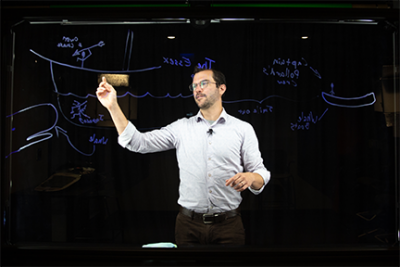 Collect your footage
Collect your footage
- Pick up your footage from the Mac located in the lobby of the Digital Union. Staff can assist you in locating your files.
- Transfer to your storage device or upload it to a cloud service such as oneDrive.
Finish the Video
If you do not have software access, visit our Hagerty Hall or Stillman Hall locations.
- Import video to Quicktime
- Click Edit > Trim to trim off the beginning/end few seconds of the video (Tutorial)
- Export video file (.mov). Click File > Export > 1080p.
- Optional: convert video to MP4 using MPEG Streamclip (tutorial starting at step #8)
- Publish video by uploading to Mediasite
Microphone Available In Room
This room has either a wired or wireless microphone on hand for voice amplification. This is for the benefit of in-person attendees, and does not amplify for students who may be attending remotely via Zoom.
Podcast Studio
Located inside the Digital Union:Work Studio in Hagerty Hall, our four-seat podcast studio features a Rodecaster mixing board, imac, four microphones and headphones. The Rodecaster allows "call-in" via bluetooth connection and sound bite recording and playback.
Printing (Poster)
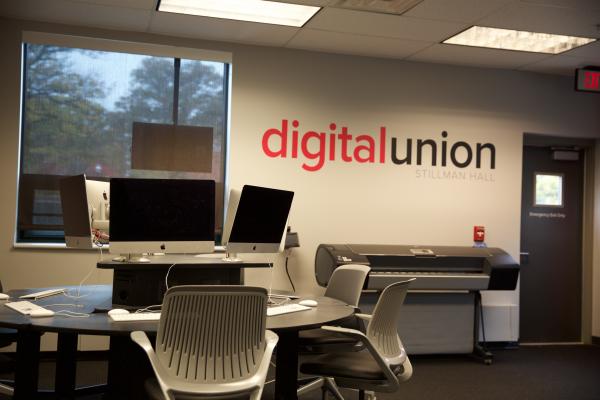
A poster printer is also commonly referred to as a "plotter." A print can take up to 30 min depending on the size, resolution, and complexity of the design.
Model & Resources
HP Designjet Z3200ps 44" Photo Printer
More about this printer
Paper type: Plain White
Cost
Cost: $1.00/square foot
Payment: BuckID only | Load Money Here
Refund: Request through Uniprint if unsatisfied with result
Common Sizes
We stock a 36" roll of plain white paper, and generally see no larger prints than 36" by 48." Recommended poster sizes vary depending on the frame and where/how it's being mounted. Here are some commonly used sizes.
Other Plotter Locations
See other locations for poster printing if our printer is unavailable or overloaded.
Printing (Standard)
Black & White Printing
Available at Digital Unions in Hagerty Hall and Prior Hall. Price is 4 cents per page (front and back count as seperate pages), and payment is BuckID only. 8.5” x 11” plain white paper.
Color Printing
Available at Digital Union Stillman Hall. Price is 15 cents per page (front and back count as seperate pages), and payment is BuckID only. 8.5” x 11” plain white paper.
Uniprint
Printing at the Digital Unions is managed by UniPrint. In case of an unsatisfactory print, a refund may be requested via this online form. For more printing options including different paper types, and printing on foamcore, visit Uniprint at the Ohio Union.
Remote-Enhanced Technology
A classroom with remote-enhanced technology has additional features beyond the standard to better allow for delivering in-person classes to students attending remotely.
Scanning (Large Document Flatbed)
Captures flat images (up to 12.2" x 17.2") through provided student computing stations. This scanner is available in our Hagerty Hall location.
Scanning (Standard Flatbed)
Captures flat images (up to 8.5" x 11.7") through provided student computing stations. Some locations may feature accessories for batch scanning slides, negatives and medium-format film. Scanners are available in our Prior Hall and Stillman Hall locations.
Standard Flat Podium
Equipped with a computer and outfitted with an external input to assist with instruction. The external input is located on the side of the podium.
Features:
- PC
- DVD player
- Mini-stereo audio input
- HDMI and VGA input
- Webcam & proximity microphone
Standard Large Podium
Equipped with a computer and outfitted with an external input to assist with instruction. The external input is located on the side of the podium.
Features:
- PC
- DVD player
- Mini-Stereo audio input
- HDMI or VGA input
- Webcam
Standard Slanted Podium
Equipped with a computer and outfitted with an external input to assist with instruction. The external input is located on the side of the podium.
Features:
- PC
- DVD player
- Mini-stereo audio input
- HDMI and VGA input
- Webcam & proximity microphone
Student Computing Station
Individual workstations are located across campus in computer rich classrooms, public computing spaces, Digital Unions and some technology enhanced informal spaces. Workstations range from walk up touch-screen kiosks for quick access, to counter height stations with stools for short term projects, to comfortable groupings for longer term project work or collaborations. Contact Classroom Services 614-688-4357 (HELP), option 4 for more information or support.
Temporary Cart - Full
A temporary a/v setup for nontraditional classroom spaces set up due to COVID-19 physical distancing requirements.
Features:
- Classroom computer with projection capabilities
- Webcam
- XLR-microphone input
- Document camera
- HDMI input
USB Charging
Need to power up between classes or while you work on a project?
Powered charging stations are available in all Digital Union locations. These stations are open to all but do not lock. This means we reccomend that you stay in the space while your device is charging.
These stations feature chargers that accomodate iPhone and Android devices.
Video Recording Studio
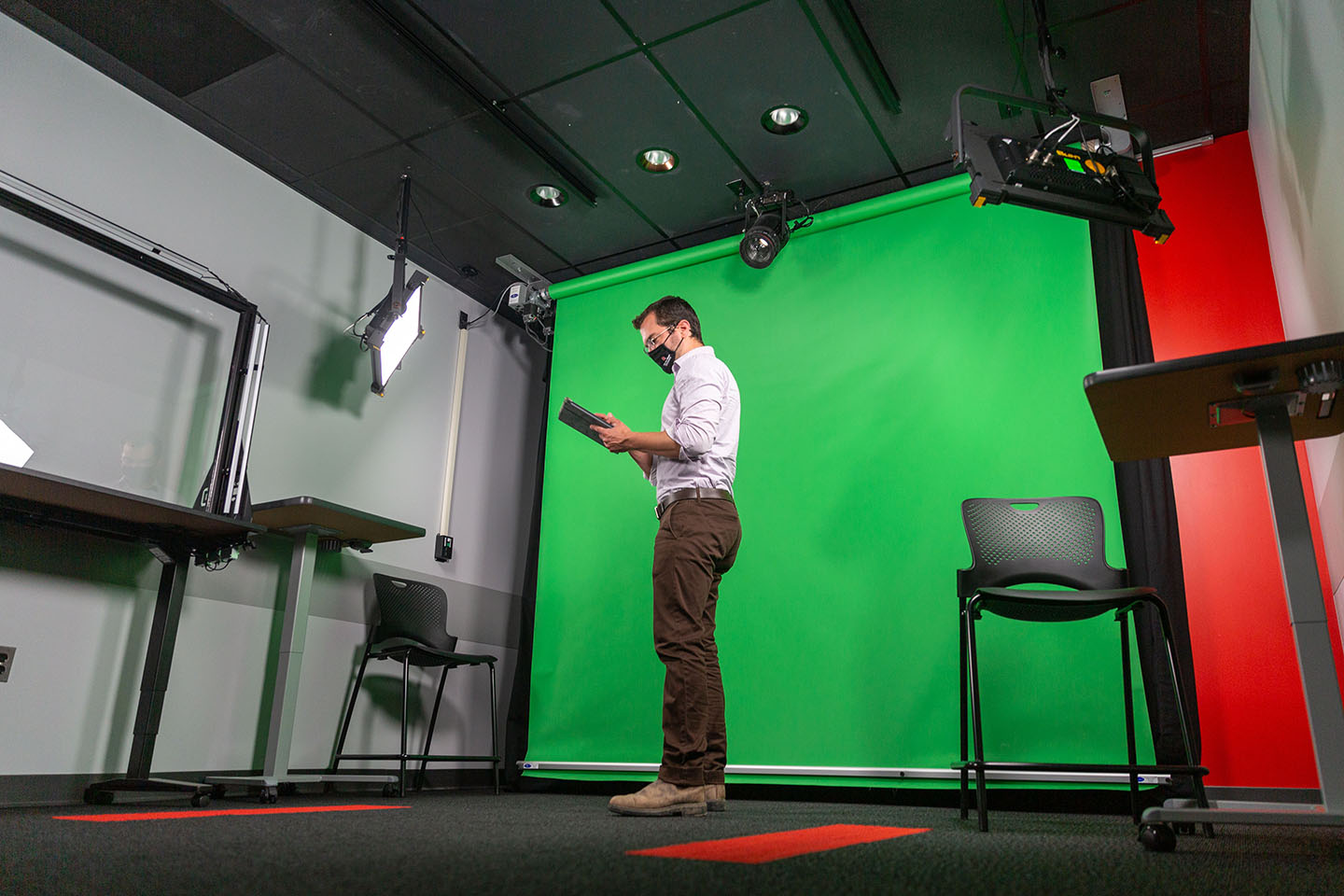 Two studios are available. Both have identical equipment and functionality despite having different sizes.
Two studios are available. Both have identical equipment and functionality despite having different sizes.Advanced Features
Picture-in-Picture: With this recording mode, instructors can deliver a lesson alongside their slides, making for a more engaging lecture capture video.
Green screen/Chromakey: Use our green screen functionality to transport yourself to a whole new world or use your lecture slides as a backdrop.
Lightboard: Record videos with our lightboard to maximize student engagement. This functionality lets you write on a whiteboard while still facing the camera and automatically flips the graphics to be legible in the final product.
Audio functionality: Switch from the in-room ceiling mic to wireless lavalier microphones, in order to capture your voice more clearly.
Lighting controls & Backdrops: Customize the look of your video.
Live mode: Take advantage of the quality of the in-studio camera and microphones and record directly to CarmenZoom.
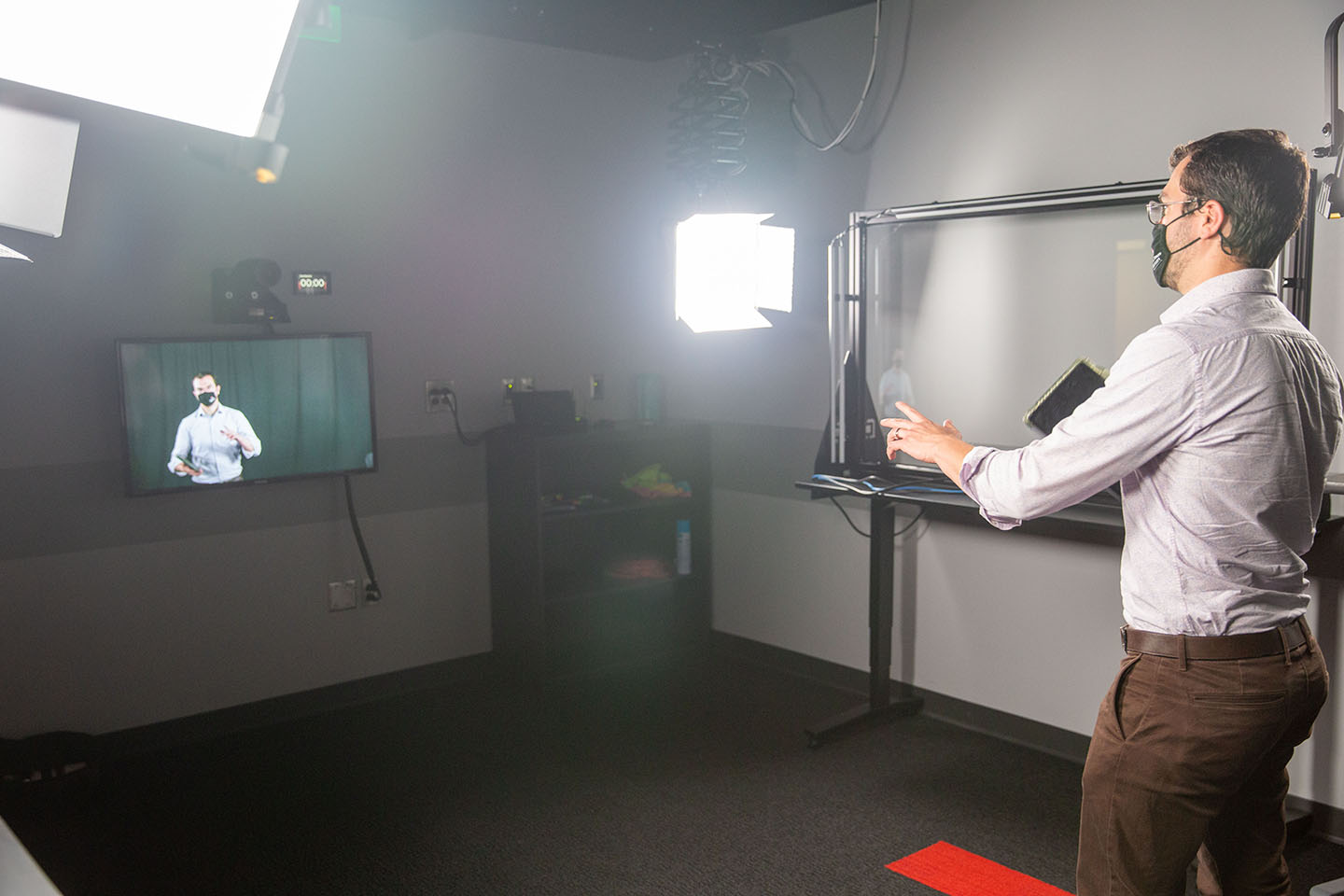
Vinyl and Paper Cutting, Scoring and Perforating
The Digital Union: Prototyping Studio has a Cricut Maker on hand to work with flat media like paper, fabric, adhesive vinyl and more. It can cut many materials, and, with the additional accessories on hand, can also draw, etch, score and perforate.
The Prototyping Studio does have some materials on hand, but anyone making multiple projects or exceptionally large projects may be asked to provide their own materials.
The DU provides a range of colors of light weight card stock, and a range of Oracal permanent adhesive vinyl, and white prototyping cardboard (ie chipboard). Additional materials such as Kraftboard, etc. may be available but cannot be guaranteed.
If you do choose to bring your own materials, you MUST have your materials approved using the materials request form before dropping them off for the item to be produced. You may even request approval of the material before you purchase it.
All materials must be no larger than 12″ x 24″.
The following is a list of general materials that will be approved for use on the Cricut Maker. This list is not exhaustive.
- Paper
- Cardstock
- Adhesive Vinyl
- Iron on/Heat Transfer Vinyl
- Kraftboard/light cardboard
- Aluminum sheets (engraving only)
- Some fabrics (please use the material approvals form for information on the suitability of a particular fabric)
- Leather (knife blade only)
- Some wood veneer (knife blade only)
- Stencil plastic
- Other paper weight items (sticker papers, labels, foils, window cling, transfer sheets, etc.)
The Cricut uses proprietary software called DesignSpace, or you can design your project in any program which can export a vector file (best is .svg) such as Adobe Illustrator or Inkscape. Our staff can assist in connecting your cricut account to our machine, or in uploading your design file to our Digital Union account.
Wall-Mounted Camera
Wall-mounted cameras are placed toward the back of classrooms, allowing for a wide view of both the instructor and the classroom. These cameras are adjustable via the control panel at the instructor station. The default camera view is a wide shot of the front of the classroom. You will find several preset options, along with advanced options such as pan, tilt and zoom to customize the view. Audio is managed through the microphone at the podium or a wireless microphone, where available. For detailed information on how to use these cameras, see Simulcasting with CarmenZoom in the Teaching and Learning Resource Center.
Features
- Pan
- Tilt
- Zoom
- Compatible with CarmenZoom
Wired Microphone Input
A wired lapel microphone can be loaned out from our service desk located in Enarson Classrooms 30. This wired lapel microphone works in select classrooms across campus. For more information or to reserve one for a wired microphone capable room, please contact (614) 688-4357.
Wireless Display
Allows the user to mirror content from mobile devices without the necessity of connection cables. The wireless display works with Android, iOS, OSX, and Windows devices.
Learn how to present wirelessly using Crestron AirMedia
Please contact Classroom Services for support.
Wireless Microphone Capable
A wireless microphone can be loaned out from our service desk located in Enarson Classrooms 30. This wireless lapel microphone works in select classrooms across campus. For more information or to reserve one for a wireless-capable room, please contact (614) 688-4357.
Wireless Microphone Connection Available
A wireless microphone hookup is provided in the room. Instructors teaching in this classroom can arrange to borrow a compatible microphone for the term from the ODEE equipment loan desk in Enarson Classroom Building. For more information or to reserve one for a wireless-capable room, please contact (614) 688-4357.
Those using mics for their classroom will need to bring them to each class session and return them at the end of the semester.
These microphones are only for voice amplification in the room for the benefit of in-person attendees, and are not necessary for reaching students who may be attending remotely via Zoom.

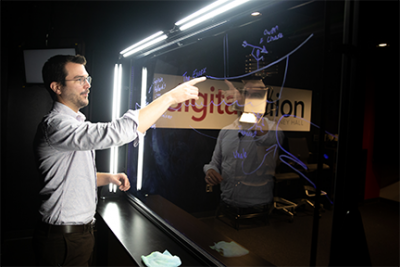
 Collect your footage
Collect your footage